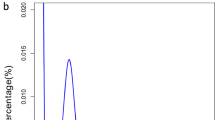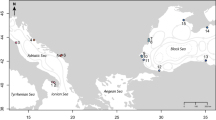Abstract
Genetic variation in the enzymes mannose phosphate isomerase and glucosephosphate isomerase was surveyed in the amphipod Megalorchestia californiana Brandt on the Pacific coast of the United States. In a series of samples from Washington state to southern California, both enzyme loci exhibited differences of allele frequency associated with latitude. Geographic differences among nine Oregon samples were not consistently associated with any obvious environmental variable.
Within the Oregon samples, the Mpi locus exhibited a heterozygote deficit in the smallest size class. Larger size classes did not differ from Hardy-Weinberg proportions. Possible explanations for this pattern include genotype-related differences in behavior, growth or viability.
Similar content being viewed by others
Article PDF
References
Ayala, F J, Hedgecock, D, Zumwalt, G S, and Valentine, J W. 1973. Genetic variation in Tridacna maxima, an ecological analog of some unsuccessful evolutionary lineages. Evolution, 27, 177–191.
Bousfield, E L. 1982. The amphipod superfamily Talitroidea in the northeastern Pacific region. I. Family Talitridae: systematics and distributional ecology. Natn Mus Natur Sci (Ottawa) Publ Biol Oceanogr, 11, 1–73.
Bowers, D E. 1964. Natural history of two beach hoppers of the genus Orchestoidea (Crustacea: Amphipoda) with reference to their complementai distribution. Ecology, 45, 677–696.
Bulnheim, H-P, and Scholl, A. 1981. Electrophoretic approach to the biochemical systematics of gammarids. Helgolander Meeresunters, 34, 391–400.
Busath, A L. 1980. Genetic differentiation of the semi-terrestrial amphipod Orchestia traskiana in an expanded habitat on Santa Cruz Island. In Power, D. M. (ed.) The California Islands: Proceedings of a multidisciplinary symposium. Santa Barbara, California, Santa Barbara Museum of Natural History, pp. 395–401.
Christensen, B. 1977. Habitat preference among amylase genotypes in Asellus aquaticus (Isopoda, Crustacea). Hereditas, 87, 21–26.
Christiansen, F B, Frydenberg, O, Hjorth, J P, and Simonsen, V. 1976. Genetics of Zoarces populations. IX. Geographic variation at the three phosphoglucomutase loci. Hereditas, 83, 245–256.
Cochran, W G. 1954. Some methods for strengthening the common chi2 tests. Biometrics, 10, 417–451.
Cooper, D W. 1968. The significance level in multiple tests made simultaneously. Heredity, 23, 614–617.
Dimichele, L, and Powers, D A. 1982. Physiological basis for swimming endurance differences between LDH-B genotypes of Fundulus heteroclitus. Science, 216, 1014–1016.
Hedgecock, D, Tracey, M L, and Nelson, K. 1982. Genetics. In Abele, L. G. (ed.) The biology of crustácea, Vol 2: Embryology, morphology, and genetics. New York, Academic Press, pp. 283–403.
Kirby, G C. 1975. Hétérozygote frequencies in small subpopulations. Theor Popul Biol, 8, 31–48.
Koehn, R K, and Gaffney, P M. 1984. Genetic heterozygosity and growth rate in Mytilus edulis. Mar Biol, 82, 1–7.
Koehn, R K, Turano, F J, and Mitton, J B. 1973. Population genetics of marine pelecypods. II. Genetic differences in microhabitats of Modiolus demissus. Evolution, 27, 100–105.
Levene, H. 1949. On a matching problem arising in genetics. Ann Math Statist, 20, 91–94.
Mantel, N, and Haenszel, W. 1959. Statistical aspects of the analysis of data from retrospective studies of disease. J Natn Cancer Inst, 22, 719–748.
McClurkin, J I, Jr., 1953. Studies on the Genus Orchestoidea (Crustacea: Amphipoda) in California. Ph.D. Thesis, Stanford University, Palo Alto, California.
McDonald, J H. 1984. Ecological Genetics of Two Polymorphic Enzymes in Three Species of Megalorchestia (Amphipoda: Talitridae). M.S. Thesis, Oregon State University, Corvallis, Oregon.
Mitton, J B, and Grant, M C. 1984. Associations among protein heterozygosity, growth rate and developmental homeostasis. Annu Rev Ecol Syst, 15, 479–499.
Nichols, E A, and Ruddle, F H. 1973. A review of enzyme polymorphism, linkage and electrophoretic conditions for mouse and somatic cell hybrids in starch gels. J Histochem Cytochem, 21, 1066–1081.
Nyman, L. 1975. Allelic selection in a fish (Gymnocephalus cernua (L.)) subjected to hotwater effluents. Rep Inst Freshw Res Drottningholm, 54, 75–82.
Poulik, M D. 1957. Starch gel electrophoresis in a discontinuous system of buffers. Nature, 180, 1477–1479.
Sassaman, C. 1978. Dynamics of a lactate dehydrogenase polymorphism in the wood louse Porcellio scaber Latr.: evidence for partial assortative mating and heterosis in natural populations. Genetics, 88, 591–609.
Shaw, C R, and Prasad, R. 1970. Starch gel electrophoresis of enzymesa compilation of recipes. Biochem Gent, 4, 297–320.
Singh, S M, and Green, R H. 1984. Excess of allozyme homozygosity in marine molluscs and its possible biological significance. Malacologia, 25, 569–581.
Smith, P J, and Francis, R I C C. 1984. Glucosephosphate isomerase genotype frequencies, homozygous excess and size relationships in the sand flounder Rhombosolea plebeia. Mar Biol, 79, 93–98.
Snedecor, G W, and Cochran, W G. 1980. Statistical methods. Ames, Iowa: Iowa State Univ. Press. 507 pp.
Sokal, R R, and Rohlf, F J. 1981. Biometry. San Francisco, W. H. Freeman, 859 pp.
Tracey, M L, Bellet, N F, and Gravem, C D. 1975. Excess allozyme homozygosity and breeding population structure in the mussel Mytilus californianus. Mar Biol, 32, 303–311.
Watt, W B, Cassin, R C, and Swan, M S. 1983. Adaptation at specific loci. III. Field behavior and survivorship differences among Colias PGI genotypes are predictable from in vitro biochemistry. Genetics, 103, 725–739.
Zouros, E, and Foltz, D W. 1984. Possible explanations of heterozygote deficiency in bivalve molluscs. Malacologia, 25, 583–591.
Zouros, E, and Krimbas, C B. 1969. The genetics of Dacus oleae. III. Amount of variation at two esterase loci in a Greek population. Genet Res, 14, 249–258.
Zouros, E, Singh, S M, and Miles, H E. 1980. Growth rate in oysters: an overdominant phenotype and its possible explanations. Evolution, 34, 856–867.
Author information
Authors and Affiliations
Rights and permissions
About this article
Cite this article
McDonald, J. Size-related and geographic variation at two enzyme loci in Megalorchestia californiana (Amphipoda: Talitridae). Heredity 54, 359–366 (1985). https://doi.org/10.1038/hdy.1985.49
Received:
Issue date:
DOI: https://doi.org/10.1038/hdy.1985.49
This article is cited by
-
Genetic population structure and gene flow among deep-sea amphipods,Abyssorchomene spp., from six California Continental Borderland basins
Marine Biology (1994)
-
Zur Ökophysiologie, Sexualität und Populationsgenetik litoraler Gammaridea — ein Überblick
Helgoländer Meeresuntersuchungen (1991)
-
Genetic differentiation between populations of Talitrus saltator and Talorchestia deshayesii (Crustacea: Amphipoda) from coastal areas of the north-western European continent
Marine Biology (1986)



